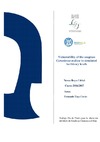Identificador persistente para citar o vincular este elemento:
https://accedacris.ulpgc.es/jspui/handle/10553/74974
| Título: | Vulnerability of the seagrass "Cymodocea nodosa" to simulated herbivory levels | Autores/as: | Royo Lleixá, Nerea | Director/a : | Tuya Cortés, Fernando José | Clasificación UNESCO: | 241705 Biología marina | Palabras clave: | Cymodocea nodosa Herbivores |
Fecha de publicación: | 2017 | Resumen: | Herbivory may affect the performance and fitness of seagrasses. The seagrass Cymodocea nodosa creates meadows of great ecological relevance. We tested whether the vulnerability of Cymodocea nodosa to a natural simulated stressor (high consumption by herbivores) differed among three seagrass meadows (Arinaga, Gando and El Castillo del Romeral). Three levels of herbivory were simulated by clipping the leaves within experimental 1-m2 plots: high herbivory (approximately 80% of leaf canopy removed), moderate (approximately 40% of leaf canopy removal) and low (no clipping; natural levels). Clipping was performed periodically (every 3-4 weeks) during 4 months throughout the summer season (June to September of 2016). At the end of the experiment, plant traits at physiological (leaf growth), morphological (number of leaves per shoot, leaf length and leaf width) and demographic (shoot density) levels were measured to assess plant responses to simulated levels of herbivory. Simulated herbivory on the three meadows of Cymodocea nodosa produced physiological, morphological and demographic changes on the plant. Moderate herbivory facilitated the growth of leaves in Arinaga and Gando meadows, what resulted in longer leaves within moderate intensity plots at these two meadows. In contrast, intense levels of herbivory delayed growth, what resulted in shorter leaves. At El Castillo meadow, however, recovery was fast; growth and leaf length did not differ between plots of varying herbivory levels. In summary, large differences in plant responses to simulated herbivory were detected among seagrass meadows. | Departamento: | Departamento de Biología | Facultad: | Facultad de Ciencias del Mar | Titulación: | Grado en Ciencias del Mar | URI: | https://accedacris.ulpgc.es/handle/10553/74974 |
| Colección: | Trabajo final de grado Restringido ULPGC |
En el caso de que no encuentre el documento puede ser debido a que el centro o las/os autoras/es no autorizan su publicación. Si tiene verdadero interés en el contenido del mismo, puede dirigirse al director/a o directores/as del trabajo cuyos datos encontrará más arriba.
Vista completaVisitas
64
actualizado el 04-may-2024
Descargas
8
actualizado el 04-may-2024
Google ScholarTM
Verifica
Comparte
Exporta metadatos
Los elementos en ULPGC accedaCRIS están protegidos por derechos de autor con todos los derechos reservados, a menos que se indique lo contrario.
